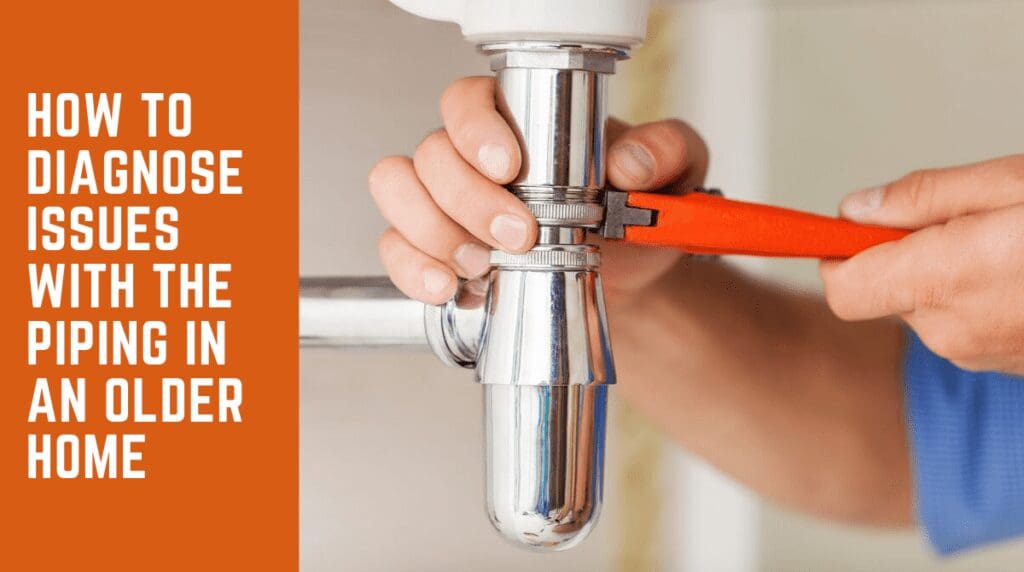Older homes are known and loved for their charm. From original hardwood to exposed brick to cute wrap-around porches, there are many parts of old homes that can cause a few worries to homeowners. One of the most common repairs that older homes fall prey to is issues with the piping. Whether it is the material that the pipe is made of or other factors related to piping, there are certain issues that can prove there are piping problems in older homes.
Galvanized & Polybutylene Piping
Galvanized and polybutylene piping were two very common pipe types that were used ranging from the ’60s to well into the ’90s. Galvanized pipes were iron pipes coated with molten zinc in an attempt to prevent the iron from corroding. This was a wonderful idea, but the zinc doesn’t last in perpetuity and can often erode and leave the iron exposed to rusting. Pipes will fail after rusting, and an indication of this is that the water will be discolored from the rust. The solution to rusted galvanized pipes is to replace the pipes with a more durable solution with a process called PEX re-piping.
PEX is a polyethylene material that is in today’s day and age the preferred material to run water lines. It’s corrosion-free, which will guarantee better-tasting water, and it has the ability to expand in order to prevent bursting in freezing temperatures.
Polybutylene was once considered one of the great water pipe materials, but a downside is that it breaks down with exposure to water. Over time, it’s all but guaranteed that these pipes will break down, so even if they haven’t yet, it’s better to swap them out for better pipes. PEX does not break down over time, making it a safer, better alternative.
Lead Service Lines
Lead service lines often go hand in hand with galvanized piping, but come with plenty of their own issues. If galvanized piping is found and replaced in your home, it is important that any lead service lines are at that time found and addressed. Lead contamination is a possibility if a filter isn’t installed to prevent contamination.
Pipe Bellies
Pipe bellies are what happens when the soil and dirt underneath houses shifts, and impacts the piping underneath. If the pipes shift downwards, the piping bends and begins to form a ‘belly’. The bend allows for sediments to build up and could potentially cause blockages.
Sewer Lines
Sewer lines, while maybe not directly tied to the house, can still cause problems to the piping. Sewer lines can have pipes that grow into them, and can also have shifted over time as the ground around them shifted. Problems with the sewer lines can be found within the home, with gurgling sounds coming from the toilet and flowing drains.
Drains
Drains are put through a lot – draining water, soap scum, shampoo, and even sewage can take decimate a drain. Clogs can develop in any drain, but most commonly in the toilet, and kitchen and bathroom sink drains. With older homes, it’s hard to know if anyone before you has taken actions that could allow a clog to form. It’s important to pay attention to water flow, and if the previous history is unknown, it would be worth it to take preemptive action.
Original Fixtures
Part of an older home’s appeal could be that it still maintains its original fixtures. While they may still look nice, that doesn’t mean that they are still functioning at the same level they did before. Washers and valves, especially, degrade over time and could be the cause of leaks in the home, and they could be ones that aren’t even visible. One of the biggest fixtures to keep an eye on is the shut-off valve on a toilet. If it gets stuck in the open position, it could cause leaks or even more serious problems if it is fixed incorrectly.
Previous Owners
One of the biggest problems with piping issues in an older home stems from previous owners, and not knowing how they treated the house. Whether it was actions that were taken by previous owners, or attempts to fix piping issues themselves, it is hard to know how they treated the house and what they may have tried to fix. Mix-and-match plumbing is usually not a good idea, so if bits and pieces look different throughout the house, it may be a good idea to think about re-piping with a PEX material that, across the board, will be a better material offering peace of mind.
What Signs to Look For
There are fool-proof things to look for that will indicate pipe issues in older homes that are simply signs, and not piping type or fixture age. One indication is noise when the faucet is turned on. Often, if pipes shift with the added water pressure, there is a bigger indication that the pipes aren’t as tightly in place as they should be. Low water pressure is also a sign of issues with piping. This could be an indication of a clog somewhere in the pipe, potentially caused by pipe bellies. Wet spots under sinks or enclosed spaces are a sign of leaking. Often, if it is under sinks, it is an indication that the fixture is not fitting correctly, or that there could be an issue somewhere in the pipe itself. Brown or discolored water is an indication that the pipes have rusted, which is especially common if the pipes are galvanized. Faucets that have a bad smell when they are not used frequently are also an indication that there is an issue with the pipe underneath the faucet.
There are many things to look for when it comes to piping problems in older homes, but all issues have a resolution! Whether it’s new fixtures or PEX re-piping the home, piping issues don’t have to make or break an older home. For more information on pex re-piping, or questions about estimates, reach out to an Allied representative!

